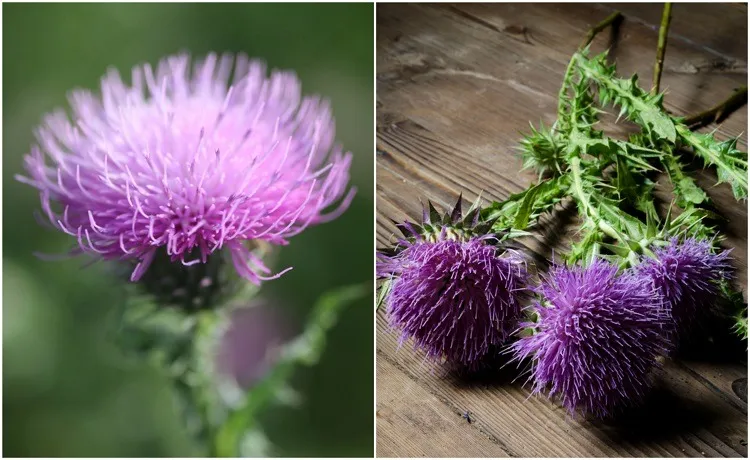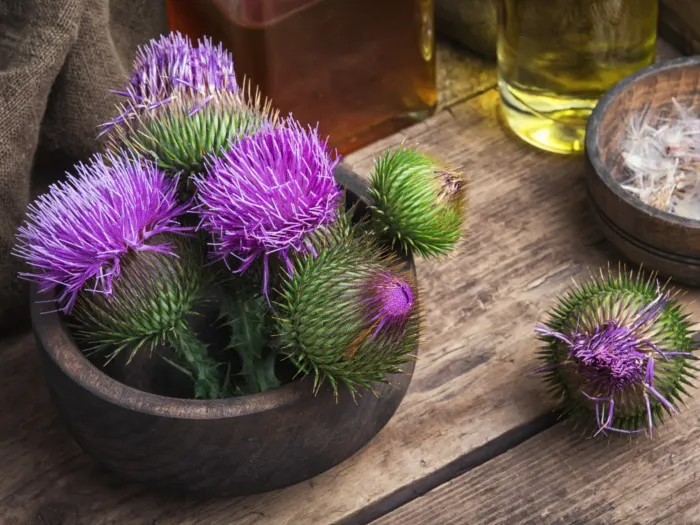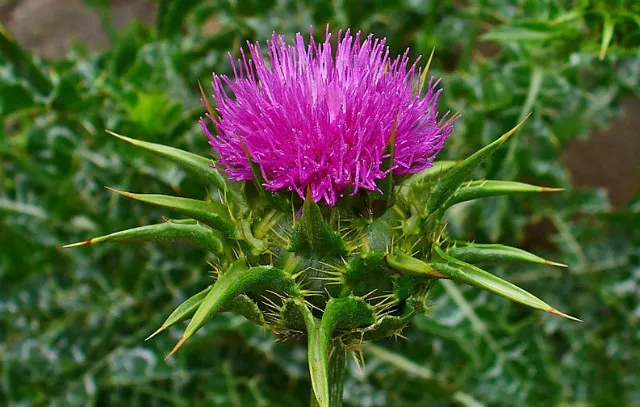
Milk Thistle - Growing, harvesting and using
We have two milk thistles growing in our yard, unfortunately i don't have any pictures but they are only about 40cm high at the moment, and on the back fence [once it grew it from under the house and started messing with the concrete, these are big plants when mature and don't mess around lol]
I am looking forward to making some tea when the plant is a bit more mature :D
Fun Facts:
Milk thistle (Silybum marianum) is a common flowering plant, within the Asteraceae family. Some of its close relatives include aster, daisy, dandelion, sunflower and ragweed. It is highly regarded for its anti-inflammatory, antioxidant and antiviral properties and has been used in traditional Chinese, European and Ayurvedic medicine for more than 2,000 years. It originated in Southern Europe, Asia Minor and the Mediterranean region, but now grows wild around the world.
Under almost any conditions, milk thistle grows 3 to 4 feet tall, featuring glossy, milky-white veined leaves and bright magenta or purple flowers beset with prickly spines. Its name results from the milky white sap its leaves release when they're crushed. Since its healing properties were first described in 40 A.D. by Greek physician and botanist Dioscorides, particularly related to treating snakebites, milk thistle has been used to treat a variety of ailments.
According to the National Institutes of Health, silymarin is the most commonly used herbal supplement in the U.S. for liver problems. All parts of the plant are edible, though its seeds are what contain that beneficial silymarin compound.
The plants do well in both sunny and lightly shaded areas of a garden and will tolerate any type of soil, and even drought. They’re so easy to care for as they can tolerate dry and wet soil, so mostly, you can just leave them be and they’ll thrive.
If they do become too weedy, deadhead the flowers before they set seed. The milk thistle flower contains as many as 190 seeds, with an average of 6,350 seeds per plant, and about 90 percent remain viable after harvest. If left untended, the seed heads will break on their own, making harvest impossible. If you plan to collect the seeds, do so before the plants fully mature.
How To Harvest Milk Thistle
Due to the thorny nature of milk thistle, putting on a pair of thick gardening gloves is a must before touching them. The leaves are extremely prickly, and the spines can easily penetrate the skin. You’ll know when they’re ready to harvest by watching for the flowers to begin drying out and produce silvery-white seed heads known as pappus.
When the milk thistle blossoms are dry, cut them off the plant from the base of the flower head.
Place the flower heads into a paper bag, and then set the bag in a warm location to allow them to completely dry, which generally takes five to seven days.
When the flower heads have thoroughly dried, place them into a burlap sack. To separate the seed, first shake the bag well and then press down on the flower heads with your hands to further separate them.
Place a bucket on the ground outside, and then pour the seeds from the burlap sack into the bucket. While you’re pouring them in, the unwanted chaff should blow away, but if any ends up in the bucket, just pick it out and discard it.
Store the milk thistle seeds in an airtight container in a cool, dark place until you’re ready to use them.

7 Benefits of Milk Thistle
Now to get to the best part!
1. Liver support
Protecting and supporting the liver is milk thistle’s most well-known benefit. The liver is our largest internal organ and it’s responsible for performing a number of essential functions. It’s constantly working hard to help defend us from the many toxins in the air that we breathe, the medications we take and the food and drink we consume, acting like a filter to remove harmful substances from the body. It also aids hormone production, releases glucose into the bloodstream so that we have a steady stream of energy, detoxifies the body and releases bile into the small intestine so that fat can be absorbed from foods.
Milk thistle helps take some of that heavy load off the liver. It helps to rebuild the liver cells while effectively reversing the harmful effects of things like the pesticides in our food, heavy metals in water, pollution in the air and alcohol or drug consumption. It’s even been scientifically approved as a treatment for a host of different liver diseases like fatty liver syndrome, as well as psoriasis, jaundice, hepatitis, damage from alcoholism and more.
2. Kidney health
The benefits of milk thistle on the kidneys have been reported to “closely mirror the herb’s effects on the liver.” It’s also said to have promise for stimulating cell regeneration in the kidneys, and may even be useful for patients who are on dialysis.
3. Lowering high cholesterol
Milk thistle, as mentioned, contains potent anti-inflammatory properties which can halt inflammation in its tracks – inflammation is one of the primary causes of heart disease. This beneficial herb supports heart health by lowering high cholesterol levels and raising “good” or HDL cholesterol, as well as reducing inflammation and preventing oxidative stress damage to the arteries. Research conducted in 2006 showed that when the extract silymarin was taken from milk thistle and used in combination with traditional treatments, total cholesterol as well as LDL, or “bad,” cholesterol, and trigylceride levels all improved, compared to participants cholesterol levels before taking the extract.
4. Preventing or controlling diabetes
Among those with diabetes, in this 2006 study, those who took silymarin for four months were found to have experienced glycemic profile improvements which included a dramatic reduction in glycosylated hemoglobin, which is a measure of blood sugar average over the prior three months, as well as reducing fasting blood glucose, total cholesterol, LDL (bad) cholesterol, and triglycerides, as compared to those who took a placebo.
It makes sense, as the liver is partially responsible for regulating the hormones, including the release of insulin, which is responsible for managing blood sugar levels. This research, coupled with the fact that the National Institute of Health notes that taking the main chemical in milk thistle silymarin, along with traditional treatments, can help control symptoms of diabetes by adding glycemic control, offers a rather compelling reason to do so.
5. Preventing gallstones
Gallstones affect at least 20 million people every year, and while it’s possible to have them and not know it, severe cases can even lead to rupturing of the gallbladder, and ultimately, death. When an attack occurs, the crippling pain can last from several minutes to a few hours or more. The pain usually starts in the abdomen and radiates to the chest, the back, and between the shoulder blades and may be accompanied by gas, heartburn, and indigestion.
As the liver and other digestive organs such as the kidneys, intestines, pancreas and gallstones work closely together, milk thistle is also known for its ability to prevent gallstones. Its benefits support both the gastrointestinal and endocrine systems by helping the production of enzymes and bile while also helping to detoxify the blood. Milk thistle can aid in purifying the body of metabolic waste, which in turns regulates the functioning of the gallbladder, as well as the spleen and kidneys.
Scientists out of the NYU Langone Medical Center reported that this beneficial herb lowers the risk of gallstones by stimulating more gallbladder contractions.
6. Better skin
The anti-inflammatory, detoxifying, demulcent and antioxidant properties of milk thistle can also help improve the condition of your skin, and even make it look younger. It can reduce visible signs of aging both inside and out, helping to prevent damage like dark spots, lines, wrinkles and discoloration. Research has shown that phytochemicals, such as those that are contained in silymarin, are effective at inhibiting UV light-induced oxidative stress on the skin, which is known to cause serious problems like skin cancer.
Studies have also suggested that applying silymarin to the skin reduces the damage caused by radiation treatment in those who’ve had cancer treatments. In one experiment conducted on mice at the University of Alabama Birmingham’s Department of Dermatology, compared to the effects of strong UV light exposure on the skin of mice. The animals who received milk thistle extract showed much less damage compared to mice who didn’t receive milk thistle.
7. Anti-aging
As we mentioned, milk thistle also offers anti-aging effects to the inside of the body, as its powerful antioxidants help to prevent free radical damage, removing toxic pollutants and waste from the blood and digestive tract. It also reduces the risk for many common and serious disorders that can come with aging, such as diabetes, heart disease, kidney and liver damage, prematurely aged skin, vision problems and cancer.
[i have taken snips of info from many different sites but they all seem to be quoting each other, so i assume cheetahbot will come for this post but meh :) ]
Cant wait for ours to get bigger at home and can start harvesting the weeds :)
Kenj xx
